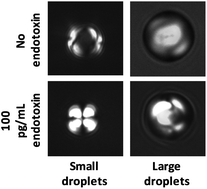We report an investigation of ordering transitions that are induced in water-dispersed, micrometer-sized droplets of a thermotropic liquid crystal (LC) by the bacterial lipopolysaccharide endotoxin. We reveal that the ordering transitions induced by endotoxin – from a bipolar state of the droplets to a radial state – are strongly dependent on the size of the LC droplets. Specifically, as the diameters of the LC droplets increase from 2 μm to above 10 μm (in phosphate buffered saline with an ionic strength of 90 mM and a pH of 7.2), we measured the percentage of droplets exhibiting a radial configuration in the presence of 100 pg mL−1 endotoxin to decrease from 98 ± 1% to 3 ± 2%. In addition, we measured a decrease in either the ionic strength or pH of the aqueous phase to reduce the percentage of droplets exhibiting a radial configuration in the presence of endotoxin. These results, when interpreted within the context of a simple thermodynamic model that incorporates the contributions of elasticity and surface anchoring to the free energies of the LC droplets, lead us to conclude that (i) the elastic constant K24 plays a central role in determining the size-dependent response of the LC droplets to endotoxin, and (ii) endotoxin-triggered ordering transitions occur only under solution conditions (pH, ionic strength) where the combined contributions of elasticity and surface anchoring to the free energies of the bipolar and radial configurations of the LC droplets are similar in magnitude. Our analysis also suggests that the presence of endotoxin perturbs the free energies of the LC droplets by ∼10−17 J per droplet, which is comparable to the standard free energy of self-association of ∼103 endotoxin molecules. The results of our investigation, when combined with prior reports of localization of endotoxin at the center of LC droplets, are consistent with the hypothesis that self-assembly of endotoxin within micrometer-sized LC droplets provides the driving force for the ordering transitions. Overall, these results advance our understanding of ordering transitions triggered by the interactions of analytes with LC droplets and, more broadly, provide guidance to the design of LC droplet systems as the basis of stimuli-responsive soft materials.

You have access to this article
 Please wait while we load your content...
Something went wrong. Try again?
Please wait while we load your content...
Something went wrong. Try again?


 Please wait while we load your content...
Please wait while we load your content...